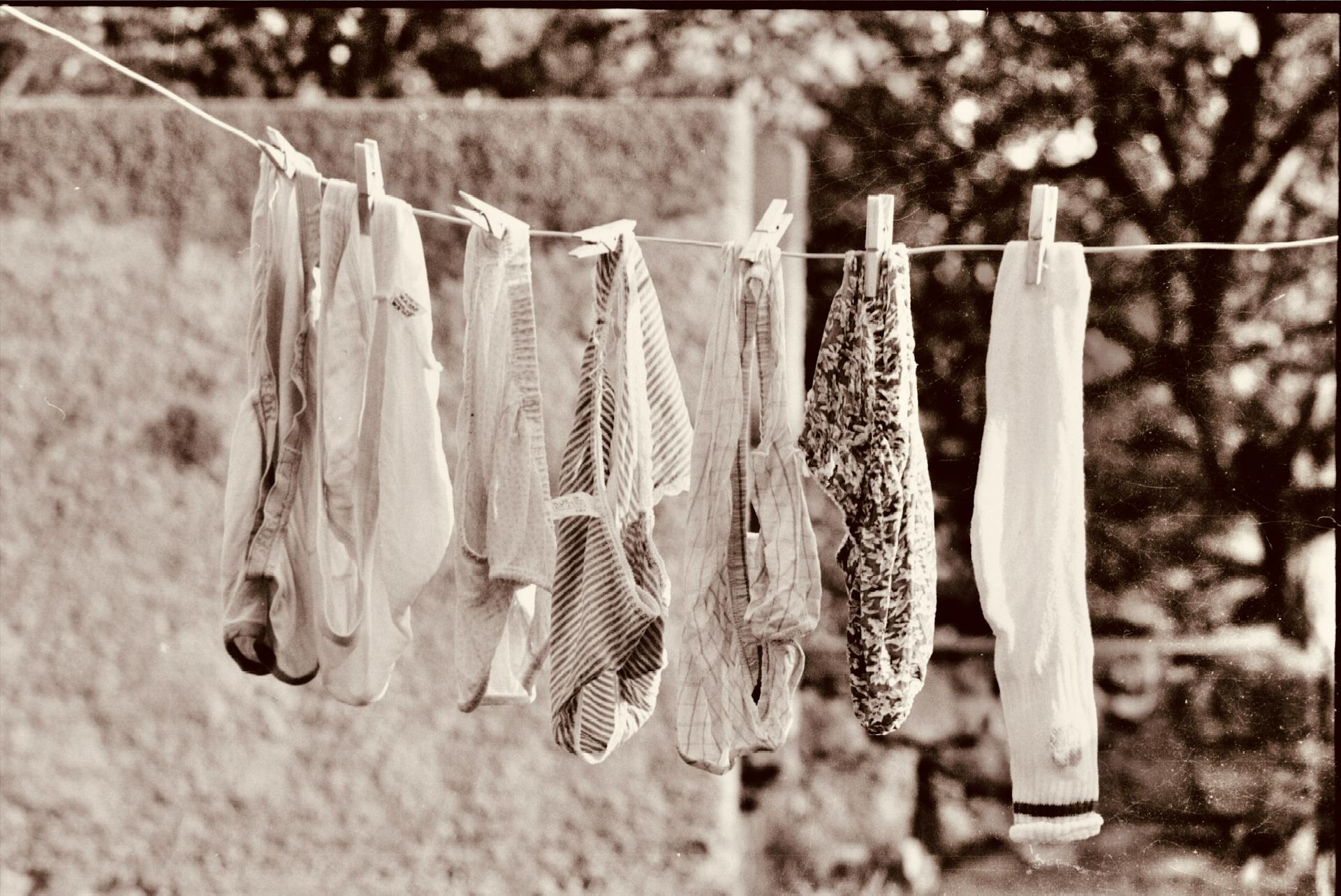
Cloth diapers for babies and toddlers can be a great way to save money and reduce environmental impact. However, if not properly cared for, you may end up with worn out and stained diapers that must be replaced. Stripping cloth diapers is a useful method to make sure they are deeply cleaned and free of any build-up so they will last longer. In this blog post, we’ll discuss the basics of how to strip cloth diapers effectively.
The first step in stripping a cloth diaper is to uninstall any liners or pads that are attached. All parts of the diaper should then be thoroughly soaked in HOT water (around 140F/60C) before being put through the washing machine as normal with no detergent or additives. On an extra hot setting, the machine will help remove more oils and soap residues that build up over time on the cloth diapers. The high temperature also helps sanitize the fabrics and loosen stains so that they come off easier in subsequent washes.
After the first hot-wash cycle, wash again using very little or no detergent or fabric softener on another hot cycle, setting aside approximately ½ cup of vinegar or baking soda in order to maintain pH balancing during the wash cycle. This combination can be used every few days until all soapy residues from previous washes are gone– usually about 2-4 hot cycles. Following every cycle, it’s important to do a sniff test as incorrect washing processes can increase ammonia levels due to bacteria growth which become smelly very quickly!
Finally, hang your freshly stripped cloth diapers out in direct sunlight– this encourages natural bleaching which can help remove stubborn stains while adding extra brightness to the fabrics– and voila! A sparkly clean diaper ready for use all over again! In conclusion, it may seem intimidating but stripping cloth diapers doesn’t have to be difficult if you use the right tools and techniques. Following these steps regularly keeps your diapers healthy, clean and longer lasting while ensuring baby gets a pleasant experience each time they wear them!
A unique perspective: Formula Stains
How do I clean heavily soiled cloth diapers?
Cleaning heavily soiled cloth diapers can seem like a daunting task and getting the job done right can be difficult. However, it doesn’t have to be such a chore. With the right tips and tricks, you can properly clean heavily soiled cloth diaper without harsh chemicals or spending excessive amounts of time scrubbing them clean.
The first step to cleaning your heavily soiled cloth diaper is to start with a pre-rinse process. Use cold water (if available) to give the diapers a quick rinse before throwing them into the washing machine. This will help loosen up any clumps of stuck on material, making it easier for your washing machine to get them completely clean. If you're dealing with a severe mess, you may want to increase the size of your pre-rinse cycle and use warm or hot water instead.
Once your pre-rinse is complete, place all of the diapers into your washing machine and use gentle detergent with low sudsing power to avoid any extra buildup in the machine or on your diapers. Use warm water and reasonable amount of detergent as well – too much detergent can result in residue being left behind on the fabrics after rinsing and unfinished sudsing in the wash cycle itself can cause an abnormal load on your appliance leading to damage over time. It's also important to only use detergents specifically designed for cloth diapers; traditional laundry detergents often contain fragrances, dyes and other ingredients that are not designed for sensitive skin or frequent uses like cloth diapering requires. After using the appropriate detergent for your load, do an extra rinse cycle if needed - sometimes multiple rinses are necessary for heavier looads with resistant soils and fabrics (such as cotton).
Following these tips should make cleaning even heavily soiled cloth diapers a breeze! Pre-rinse regularly, use gentle detergents at appropriate proportions, run multiple rinse/wash cycles if needed and you’ll see spotless results each time!
If this caught your attention, see: Cloth Diaper
What products should I use to wash cloth diapers?
Cloth diapers can be an intimidating switch from disposable diapers, especially when it comes to figuring out what kind of products to use on them. To ensure that cloth diapers stay in the best condition possible, it is important to use the correct laundry products in order to not only disinfect and clean them but to also preserve the quality of the material.
When it comes to washing cloth diapers, you should use the mildest detergent that does the job. It is important to avoid any detergents which contain fabric softeners and fragrances as these can affect absorbency. A concentrated formula is generally recommended as compared to a standard store-bought brand as they are typically formulated specifically for cloth diapers. To achieve a deep clean, special agents such as bleach, baking soda or vinegar may need to be used; not all fabrics will react well with these agents so it is important to pay attention. There are even special detergents designed for cloth diapering purposes in hopes of avoiding any potential issues when laundry time rolls around.
It may require some trial and error at first but once you find a system that works, it’s easy keep up a healthy laundry routine for your cloth diapers!
Readers also liked: Clean Smoke Damaged Clothes
How can I prevent staining on cloth diapers?
Cloth diapers can be a great alternative to disposable diapers. But before you can make the switch, one key question is how to prevent stains on cloth diapers. Fortunately, there are some simple solutions that can help keep your diapers looking like new and avoid staining your little one’s clothes at the same time.
The most important step to preventing diaper stains is changing your baby’s diaper as soon as they need it. The longer their wet diaper goes unchanged, the more likely it will leak onto their clothing and become difficult to remove. Additionally, keeping the diaper away from direct sunlight will help minimize staining. Sunlight causes stains to set into fabric immediately which makes them harder to remove. If you find yourself outside for extended periods of time with your baby, consider using a waterproof cover over their diaper so as not to ruin their clothing or fabric of their car seat/stroller cushions.
When it comes to removing existing stains, an enzyme detergent works best. Look for laundry detergents that contain enzymes and add a bit more than recommended during washing cycles in order to make sure all of the stain is removed completely. Another option is letting soap build up over stained areas before washing; this method helps break down tough staining particles that might have adhered themselves onto the fabric’s fibers creating a stubborn stain after multiple washes or sun exposure – make sure any towels or items included in the wash cycle that don’t have stains on them get rinsed after soaping up the diaper before washing in order to avoid any residue from sticking onto other items! Lastly, try soaking stained areas with hydrogen peroxide in order for stubborn stains like formula or breastmilk from becoming permanent on cloth diapers. After using this method make sure you rinse off all of the peroxide with warm water prior to washing for optimal results! With these few tips and tricks cloth diapering can not only be inexpensive but also easier when it comes maintaining cleanliness and avoiding unwanted staining disasters!
Readers also liked: Washing Clothes Kill Fleas
Is it necessary to use a special detergent for washing cloth diapers?
Answering the question of whether or not you need to use a special detergent for washing cloth diapers is not a straightforward one. Cloth diapers have unique demands and require vigilant attention to ensure they are kept clean and healthy. Although using a special detergent is often recommended, it’s not always necessary.
For those who do opt for a special detergent, there are plenty of options available. Many brands contain no fragrances and extra ingredients that ca be harsh and cause irritation; containing only the essentials that clean effectively yet gently and are designed specifically for delicate baby skin. Special diaper detergents usually last longer too so you get more use out of them, making them an economical choice.
On the other hand, if you decide to go with less specialized products, look for ones with fewer additives as well as natural or organic elements as much as possible. To make sure the diapers come out clean yet still protect your baby’s skin, it’s suggested to do a double rinse process on cloth diapers before they’re ready to be worn again.
At the end of the day, whether you choose something made especially for washing cloth diapers or use something more common like mild liquid detergents without dyes or perfumes your ultimate goal should be cleanliness with gentle care in mind with every wash; this way your little one is completely safe and secure wearing freshly washed cloth diapers!
For more insights, see: Clean Asbestos
Are there any tips for pre-treating cloth diaper stains?
Preventing and treating cloth diaper stains is no easy task. Between diaper blowouts and normal wear and tear, it can seem like you’re spending more time tending to your child's dirty diapers than actually enjoying their cute little faces! To save you from some of the headache, here are a few simple tips for pre-treating and preventing cloth diaper stains:
First, use only approved detergents for your diapers in order to limit risk of staining. Organic soapnuts are an excellent choice for cloth diapers because they are all natural, non-toxic and safe for your little one’s delicate skin. Additionally, avoid fabric softeners as they can lead to staining on the fabric.
Next, use a stain remover spray directly on your clutters before washing them to help keep them looking clean longer. Be sure to read the directions on each specific product to make sure it won't damage the materials or cause irritation to your babe's sensitive skin. If you notice persistent staining or discoloration, try a chlorine-free bleach alternative or oxygen bleach every now and again - but not too frequently or it could weaken or change the color of the fabric of your diaper over time.
Finally, hang wet diapers out in the sun whenever possible to keep them looking fresh. Natural sunlight is one of nature’s best bleaching agents! Use this natural dye-stripper once a week with pre-treated clothes if you want to avoid overuse of chemical treatments such as chlorine bleach. Plus, this helps kill bacteria and brighten up fabrics at the same time!
By following these few simple tips for pre-treating cloth diaper stains, you can ensure that your child's diaper stays looking fresh as long as possible!
For more insights, see: Cloth Diapers
What is the best way to dry cloth diapers after washing?
Nowadays more and more parents are opting for the eco-friendly route of using cloth diapers for their little ones. But it's important to know the best way to dry them after washing in order for them to last a long time, remain absorbent and most importantly – stay bacteria-free!
One of the best methods for drying cloth diapers is air-drying. This involves hanging the diapers outdoors or in cabinets that get direct sun. However, you can also air-dry them indoors if you don’t have access to an outdoor area or a balcony. Line dry your diapers onto a drying rac k in a well-ventilated area free of moisture and humidity. Avoid drying them with other clothes, as the damp fabric may cause colors on the other clothes to bleed.
You can also use a tumble dryer on low heat setting and with no fabric softener sheets, as this can render absorbent materials less absorbent over time. However, be sure not to leave it too long in the tumble dryer as this can cause material shrinkage!
All in all, air-drying should be your go-to method as it's best for preserving the quality of your cloth diapers over time. If you really want to use a tumble dryer make sure to use only low heat settings and no fabric softener sheets! With these tips you'll have clean and safe cloth diapers that will last quite awhile!
Broaden your view: Dryer Sheet Smell
Featured Images: pexels.com


